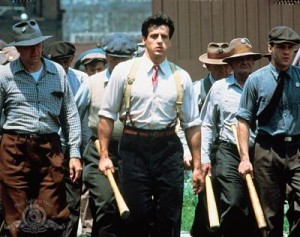STUDIO: Kino Lorber | DIRECTOR: Norman Jewison | CAST: Sylvester Stallone, David Huffman, Peter Boyle, Rod Steiger, Kevin Conway, Melinda Dillon, Tony Lo Bianco, Brian Dennehy
RELEASE DATE: 2/10/15 | PRICE: DVD $19.95, Blu-ray $29.95
BONUSES: featurette
SPECS: PG | 145 min. | Drama | 1.85:1 widescreen | DTS Stereo/Dolby Digital 5.1RATINGS (out of 5 dishes): Movie
| Audio
| Video
| Overall
F.I.S.T., a thinly veiled 1978 telling of the Jimmy Hoffa story and the rise of labor unions in America is an ambitious, colorful misfire that benefits greatly from the talents of its production team—more so than it does from its leading man and co-screenwriter, Sylvester Stallone (Escape Plan).
Stallone portrays charismatic Cleveland laborer Johnny Kovak, who joins a local chapter of a union in the 1930s. Over the next three decades, Johnny rises through the organization, and as his power grows, his methods and aims become more volatile and questionable. By the time the 1960s rol around, Johnny is being investigated by a U.S. Senate about his questionable ties to the Mafia.
A large-scale period piece directed with competence and a solid pace by veteran Norman Jewison (Fiddler on the Roof), F.I.S.T. originates from a screenplay by Joe Eszterhas, his very first, and was then fiddled with by Stallone, who is credited as the film’s co-screenwriter (more on that later). Other superlative production credits include cinematographer by the great Laszlo Kovacs (Easy Rider), music by Bill Conti (Rocky), production design by Richard MacDonald and costumes by Anthea Sylbert. And the prowess of the onscreen talent, which includes Rod Steiger (On the Waterfront), Peter Boyle (Taxi Driver), and Tony Lo Bianco (Kill the Irishman), speaks for itself.
The disc includes the featurette The Fight for F.I.S.T., an 18-minute featurette that includes new interviews with screenwriter Eszterhas and director Jewison. Both offer memorable tidbits about the film and its production, the more colorful coming from Eszterhas. He tells of how his screenplay was picked up by MGM, who then had him mold the story’s most personal elements of the story into a more Hoffa-esque narrative. He also talks about how about Stallone, fresh off Rocky, had risen to folk hero status and was very concerned about his image. Stallone insisted on a re-writing the screenplay and, according to Eszterhas, primarily changed the “romantic” scenes that he shared with Melinda Dillon (A Christmas Story), which are noticeably the weakest parts of the movie. Jewison remembers how Stallone didn’t want his character to die at the end—“the hero shouldn’t die,” he reasoned—but the studio and common sense managed to keep in Johnny’s climactic murder by hoods.
F.I.S.T.’s epic vision of labor, politics and corruption in 20th Century America a la The Godfather or Once Upon a Time in America never quite clicks and for that, I blame Stallone. While his performance is acceptable—it’s not bad at all, actually—his sandwiching in of a romantic aspect softens what’s down and more time could have been spent on union story and Stallone’s relationship with other men whose arc span the film’s three decades, particularly his best friend and fellow union man Abe Belkin (David Huffman).
On a most humorous final note in the featurette, Eszterhas talks about how Stallone was a strong presence and talking head during F.I.S.T.‘s initial marketing and rollout, but when the film was poorly received by the critics and at the box office, Stallone essentially shifting the blame towards Eszterhas’s script.
“It was my first run-in with Hollywood cynicism,” grunts Eszterhas.
|
Buy or Rent F.I.S.T.
|
|||
|---|---|---|---|
DVD |
 |
||

Leave a Reply